Greater Penang Conurbation
The Greater Penang Conurbation, also known as the George Town Conurbation,[1][2][3] is the built-up urban or metropolitan area within and around the Malaysian state of Penang. Encompassing the entire State of Penang, and parts of the neighbouring states of Kedah and Perak, the conurbation was home to over 2.83 million people as of 2020, the second largest in the country after the Klang Valley.
George Town Conurbation | |
|---|---|
From top, clockwise: George Town CBD, aerial view of Perai, a clock tower in Sungai Petani, Bayan Lepas Free Industrial Zone, a clock tower at Parit Buntar, Kulim Hi-Tech Park | |
| Country | Malaysia |
| State | |
| Region | Penang Kuala Muda District Kulim District Bandar Baharu District Kerian District |
| Area | |
| • Total | 3,961 km2 (1,529 sq mi) |
| Population (2020) | |
| • Total | 2,833,957 |
| • Density | 720/km2 (1,900/sq mi) |
| Time zone | UTC+8 (Malaysian Standard Time) |
| Postcode | 09xxx, 10xxx, 11xxx, 12xxx, 13xxx, 14xxx, 34xxx |
| Area codes | +604 (-2, -4, -5, -6 and -8), +605-7 |
As the capital city of Penang, George Town also forms the core city of the conurbation, which covers an area of 3,961km2. The metropolitan area includes Seberang Perai, the towns of Sungai Petani, Kulim and Bandar Baharu in Kedah, and Kerian in Perak.
History
Originally founded as an entrepôt, George Town's diversified economy is powered by the twin major sectors of manufacturing and services. Penang's path to industrialisation began in the 1970s with the establishment of free industrial zones at Bayan Lepas and Perai. As Penang's industries rapidly scaled up the value chain, the border towns in neighbouring Kedah, specifically Sungai Petani and Kulim, also started to witness economic spillover resulting from agglomeration effects and the rise in the standard of living within the former.[4] In 1996, the Kulim Hi-Tech Park was opened as an extension of Penang's electronics manufacturing industry.
However, interstate coordination in urban development was lacking, causing development policies to be disjointed while an urban sprawl radiated out of Penang's borders into Kedah and Perak. In the early 2000s, the Malaysian federal government drafted the National Physical Plan (NPP), in which the concept of a George Town Conurbation was borne out of the desire by policy planners to decentralise urban development to four major metropolitan areas in Peninsular Malaysia.[5][6] The National Physical Plan 2 (NPP-2), endorsed in 2010, gave an official definition to the George Town Conurbation, stretching from Sungai Petani in the north to Kerian, Perak in the south.
In 2011, the then Malaysian Prime Minister, Najib Razak, announced plans to intensify infrastructure investment in Penang as part of a 'Greater Penang Masterplan'.[7] The strained federal-state ties following the 2013 general election led the Barisan Nasional-controlled federal government to slash development expenditures in Penang, then an opposition state held by the Pakatan Rakyat coalition.[8] This state of affairs continued until the 2018 general election, which saw the first regime change in Malaysian history that resulted in both the federal and the Penang state governments being helmed by the same coalition for the first time since 2008.
Definition
The George Town Conurbation comprises the entirety of Penang, Kedah's southernmost towns of Sungai Petani, Kulim and Bandar Baharu, and Kerian in Perak, covering an area of 3,961km2.[6]
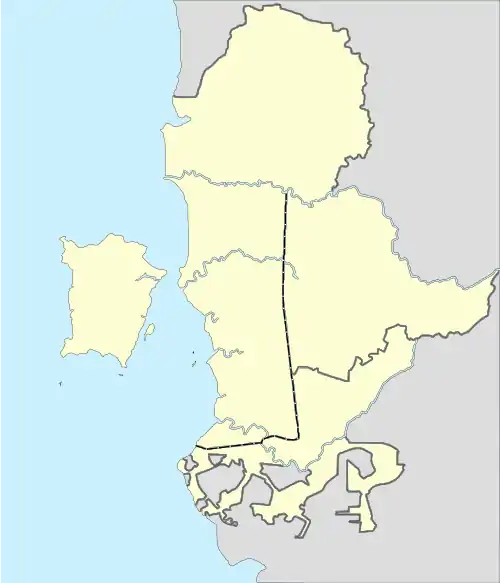
Population by local government area
The population table is based on the official census of 2020 for the local government areas within the George Town Conurbation.
| Local government area | Local government body | Population |
|---|---|---|
| Penang Island | Penang Island City Council | 794,313 |
| Seberang Perai | Seberang Perai City Council | 946,092 |
| Sungai Petani | Sungai Petani Municipal Council | 545,053 |
| Kulim | Kulim Municipal Council | 319,056 |
| Kulim Hi-Tech Industrial Park Local Authority | 18,679 | |
| Bandar Baharu | Bandar Baharu District Council | 44,412 |
| Kerian | Kerian District Council | 166,352 |
| George Town Conurbation | 2,833,957 | |
Transportation
Land
George Town is connected to mainland Peninsular Malaysia by two bridges. The 13.5 km (8.4 mi) Penang Bridge, completed in 1985, spans the Penang Strait between Gelugor on the island and Perai on the mainland. The 24 km (15 mi) long Second Penang Bridge was opened in 2014, linking Batu Maung on the island to Batu Kawan on the mainland.
Both the North–South Expressway and the Malayan Railway's West Coast Line provide direct overland connection between Sungai Petani, Seberang Perai, Bandar Baharu, Kerian and the west coast of the peninsula, while Kulim and its Hi-Tech Park are accessible from Seberang Perai via the Butterworth–Kulim Expressway.
Within George Town itself, the Tun Dr Lim Chong Eu Expressway is a vital coastal highway that runs along the island's eastern seaboard, connecting the city centre with the Penang Bridge, the Bayan Lepas Free Industrial Zone, the Penang International Airport and the Second Penang Bridge. The Federal Route 6 is a pan-island trunk road, while the two major ring roads in the city are the George Town Inner Ring Road and the Penang Middle Ring Road.
Public transportation
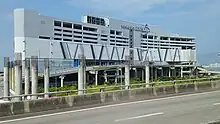

Public bus services are mainly provided by Rapid Penang, which operates 56 routes within the conurbation, including interstate routes into Kedah and Perak. Among the routes are free-of-charge transit services such as the Central Area Transit, the Congestion Alleviation Transport and the Pulau Tikus Loop.[9]
Meanwhile, the only rail-based transportation system within Penang is the century-old Penang Hill Railway, a funicular railway to the peak of Penang Hill. The Penang state government has also drawn up plans to introduce urban rail throughout Penang, as part of the Penang Transport Master Plan.[10][11] The 29 km (18 mi) Bayan Lepas LRT line, stretching between Tanjung Bungah and Bayan Lepas with an interchange station at Komtar, is being prioritised for construction.[12][13] Other lines being proposed are a cross-strait light rail line linking George Town and Butterworth, a monorail line connecting the centre of George Town with Air Itam and Paya Terubong, and a tram line limited to within George Town's UNESCO World Heritage Site.[14][15][16][17]
Efforts are also being undertaken to promote pedestrianisation and the use of bicycles as an environmentally friendly mode of transportation.[18][19] Dedicated cycling lanes have been paved throughout the city and in 2016, George Town became the first Malaysian city to operate a public bicycle-sharing service, with the inauguration of LinkBike.[20][21][22]
Penang Sentral at Butterworth is the main transit hub within Penang. It is adjacent to the Sultan Abdul Halim Ferry Terminal and the Butterworth railway station, allowing it to function as a termini for public and interstate buses, ferry and train services.
Air
The Penang International Airport (PEN) at Bayan Lepas serves as the main airport for northern Malaysia, with frequent links to major regional cities such as Kuala Lumpur, Singapore, Bangkok, Jakarta, Ho Chi Minh City, Taipei, Hong Kong, Guangzhou and Doha. Penang International Airport is Malaysia's second busiest in terms of cargo traffic and recorded the third highest passenger traffic of all Malaysian airports as of 2013.[23]
The airport is also a hub for two Malaysian low-cost carriers - AirAsia and Firefly.[24] Among the international carriers that operate out of the airport are Scoot, Jetstar Asia Airways, China Airlines, China Southern Airlines, Thai Smile and Qatar Airways.
Sea

The Port of Penang, the main harbour in northern Malaysia, is operated by the Penang Port Commission. The Port consists of seven facilities, with six of them in Butterworth and Perai, including the North Butterworth Container Terminal, Butterworth Deep Water Wharves and the Prai Bulk Cargo Terminal. The Port of Penang, the third busiest seaport in Malaysia, handled more than 1.52 million TEUs of cargo in 2017.[25]
Meanwhile, Swettenham Pier, situated in the heart of George Town, is the sole Port facility on Penang Island. The pier now accommodates cruise ships, making it one of the major entry points into Penang. As of 2017, Swettenham Pier recorded 1.35 million tourist arrivals, thereby surpassing Port Klang as the busiest cruise shipping terminal in Malaysia.[26][27][28] The pier also serves as a homeport for regional-based cruise ships.[26]
The cross-strait Penang ferry service connects George Town and Butterworth, and was formerly the only transportation link between Penang Island and the mainland until the completion of the Penang Bridge in 1985.
References
- "Government banks on intensive urbanisation to pull investment". The Malaysian Insider. 16 August 2010. Retrieved 19 June 2013.
- "Turning Penang into a model state". The Edge. 4 October 2010. Retrieved 19 June 2013.
- "The State of Penang, Malaysia : Self-Evaluation Report" (PDF). OECD Reviews of Higher Education in Regional and City Development. National Higher Education Research Institute (2010).
- "Northern Corridor Economic Region Strategic Development Plan (2021-2025)" (PDF). Northern Corridor Economic Region.
- "An Overview of Spatial Policy in Malaysia". www.mlit.go.jp. Retrieved 2023-10-18.
- Homi Kharas, Albert Zeufack, Hamdan Majeed. "Cities, People and the Economy: A Study on Positioning Penang" (PDF). Khazanah Nasional, World Bank.
{{cite journal}}: CS1 maint: multiple names: authors list (link) - admin. "Penang welcomes the Federal Government's initiative by Prime Minister Dato' Sri Najib Tun Razak to co-develop a Greater Penang Masterplan – Lim Guan Eng". Retrieved 2023-10-18.
- Gooi Hsiao Leung, Ooi Kee Beng, Francis Loh Kok Wah. "Enabling Decentralisation and Improving Federal-State Relations in the Federation of Malaysia" (PDF). Penang Institute.
{{cite journal}}: CS1 maint: multiple names: authors list (link) - Opalyn Mok (5 March 2018). "Penang to launch another free bus service next month". Malay Mail.
- Ooi, Kee Beng (2010). Pilot Studies for a New Penang. Singapore: Institute of Southeast Asian Studies. ISBN 9789814279697.
- "Constitution of Malaysia" (PDF). Archived from the original (PDF) on 14 May 2011. Retrieved 11 June 2011.
- Mok, Opalyn (2023-05-11). "Penang at 'tender stage' for LRT project, says Kon Yeow". Malay Mail. Retrieved 2023-10-14.
- "Penang's first LRT alignment is now from Bayan Lepas to Tanjong Bungah | Buletin Mutiara". https://www.buletinmutiara.com/. 2023-05-30. Retrieved 2023-10-14.
{{cite web}}: External link in|website= - "Penang to ease island's transport woes". The Straits Times. April 17, 2015.
- "Keeping folk in the know - Community | The Star Online". www.thestar.com.my. Retrieved 19 October 2016.
- Loh, Arnold. "More rail access for Penang - Nation | The Star Online". Retrieved 19 October 2016.
- Chow, Tan Sin (15 August 2015). "Trams making comeback under RM27bil Penang plan". The Star.
- Opalyn Mok (9 August 2016). "Making George Town more walkable, one street at a time". Malay Mail.
- Opalyn Mok (1 March 2018). "Penang streetscapes to be more pedestrian friendly, says exco". Malay Mail.
- "Penang tourism: Promoting cycle lanes in urban heritage areas". The Sun. 24 January 2015.
- Arnold Loh (29 April 2016). "Pedal power can set a new benchmark of liveability in Penang". The Star. Archived from the original on 3 May 2016. Retrieved 18 October 2016.
- Lilian Chan (8 February 2017). "Penang to be first cycling state". Buletin Mutiara.
- "Malaysia Airports". Archived from the original on 28 March 2014. Retrieved 18 November 2016.
- "Handy Penang airport information from Skyscanner". www.skyscanner.com.my. Retrieved 2018-02-19.
- Chong, Kah Yuan (26 February 2018). "Penang Port allocates RM186mil capex for two years". The Star.
- Filmer, Andrea (1 October 2015). "Is Penang's tourism on the right track?". Penang Monthly. Archived from the original on 22 March 2019. Retrieved 17 October 2016.
- Edmund Lee (20 December 2017). "Swettenham Pier surpasses Port Klang as top port of call for cruise ships". The Sun.
- "More liners to visit Penang". The Star. 16 December 2017.
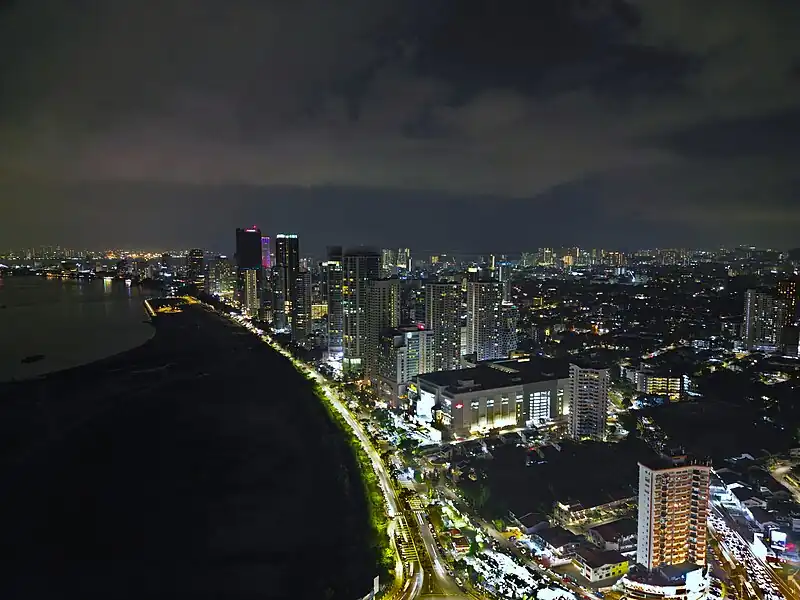
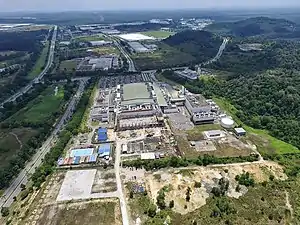
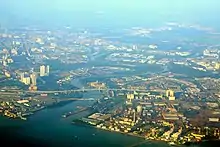



.jpg.webp)

